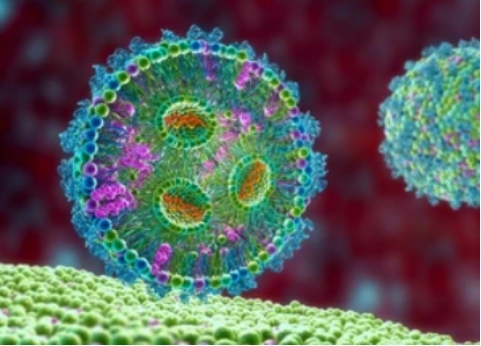Exosomes for siRNA Delivery
Online InquiryExosomes are known to have a large capacity and efficient ability to deliver biomacromolecules although their functions are not fully understood. Due to their unique features, such as membrane-permeable and low immunogenicity, exosomes have been increasingly used as a carrier for gene and drug delivery. The use of small interfering RNAs (siRNAs) to induce gene silencing has emerged as a promising therapeutic alternative for diseases, however, poor bioavailability limits its therapeutic potential. As a promising tool for nucleic acid drug delivery across different biological barriers, exosomes have been widely used to deliver siRNA.
The capability of exosomes to act as natural carriers for siRNA delivery
In recent years, siRNA has received increasing attention as the preferred mechanism for inducing gene silencing due to its high specificity, efficacy, ease of synthesis, and low side effects. siRNAs are double-stranded RNA molecules ranging in length from 19 to 25 nucleotides. RNA interference (RNAi) via siRNAs, which is similar to many miRNAs that trigger sequence-specific catalytic mRNA degradation. Since siRNA is characterized by large molecular weight and polyanionic, its passive uptake by cells is poor. In addition, naked siRNA is also unlikely to be injected into systemic circulation due to the possibility of rapid degradation by plasma nucleases. Encapsulation of siRNA in nanocarriers may facilitate efficient delivery and uptake of siRNA into target cells. Exosomes have a structure consisting of a hollow, aqueous core enveloped by a phospholipid bilayer, which not only has good stability in blood but also can deliver functional RNA into target cells, making it an ideal system for siRNA encapsulation.

Methods for loading siRNAs into exosomes
- Electroporation
Electroporation is a safe and widely used method for loading siRNAs into exosomes. However, this method is inefficient and can lead to protein aggregation. In order to deliver sufficient amounts of siRNAs to target cells for a potent gene knockdown, an optimized encapsulation method needs to be developed.
- Transfection with specific reagents
This method is proposed as an alternative approach for loading siRNAs into exosomes. Lipofectamine-combined siRNAs are first incubated with the extracellular vesicles and then siRNA-loaded exosomes are cultured together with the target cells. In addition to cytotoxicity, the main drawback of this method is that it is not clear whether the transfection is the result of lipofectamine or exosomes.
- Transfecting donor cell
In this method, the parental cells are transfected with siRNAs and subsequently released into the exosomes via the parental cells. However, the problems of this approach are similar to transfection with specific reagents with improper packaging, lacking specificity, and cytotoxicity.
Support of exosomes as drug carriers
Creative Proteomics has over a decade of experience in exosome multi-omics services and has provided quality services to our global clients. Our dedicated team is able to provide exosome research to researchers in pharmaceutical and biotechnology as well as academic and government institutions. Our exosome isolation and purification services are flexible and customized to support the production of high-yield and pure intact exosomes suitable for subsequent loading of siRNA. In addition, we also offer other services to meet a wide range of exosome research and applications.
| Exosome analysis services | |
|---|---|
| Exosome isolation and purification | Sucrose gradient centrifugation |
| Polymer-based exosome enrichment method | |
| Immunomagnetic bead method | |
| Size exclusion chromatography method | |
| Exosome identification | Nanoparticle tracking analysis (NTA) |
| Electron microscopy analysis | |
| Western blot | |
| Exosome marker assay | Isolation and enrichment of exosomal CD9, CD63, CD81, TSG101, HSP70 proteins |
| Exosome surface protein identification and quantitative analysis | |
| Exosome engineering | Exosome labeling and tracking |
| Cargo loading | |
| Engineered exosome production | |
| Cargo loading assessment | |
| Exosomes labeling and tracking | Exosome fluorescent labeling |
| Fluorescence exosome purification | |
| Fluorescent exosome concentration labeling | |
| Exosome multiomics analysis | Exosome proteomics analysis: Exosome protein profile identification Exosome protein composition analysis Exosome protein expression level analysis Exosome protein differential expression analysis |
| Exosome metabolomics analysis: Exosome differential metabolite screening Qualitative and quantitative analysis of target metabolites/metabolic pathways | |
| Exosome lipidomics analysis: Exosome lipid composition and level analysis Differential expression analysis of exosomal lipid molecules Qualitative and quantitative analysis of targeted lipid molecules | |
| Exosomal biogenesis and identification | Our capabilities will provide strong support for the study of exosome biogenesis and its identification. |
| Exosomal cargo and loading mechanism | Our services can greatly help the study of exosomal cargo and loading mechanism, facilitating the diagnostic and therapeutic applications of exosomes. |
| Exosome function research | In vitro analysis of the function of exosomes In vivo analysis of the function of exosomes |
Reference
- Faruqu, Farid N., Lizhou Xu, and Khuloud T. Al-Jamal. "Preparation of exosomes for siRNA delivery to cancer cells." JoVE (Journal of Visualized Experiments) 142 (2018): e58814.
* For Research Use Only. Not for use in diagnostic procedures.



